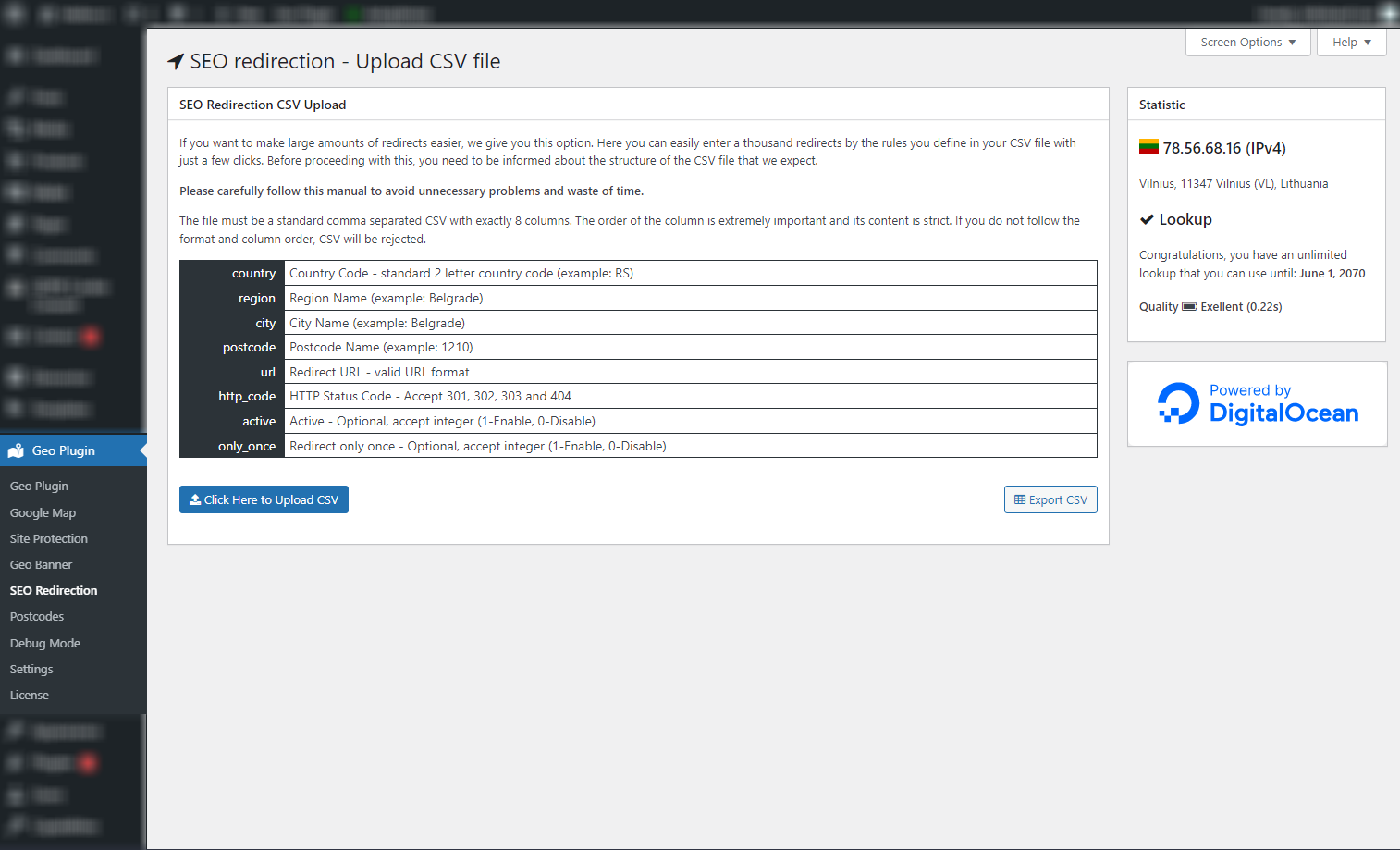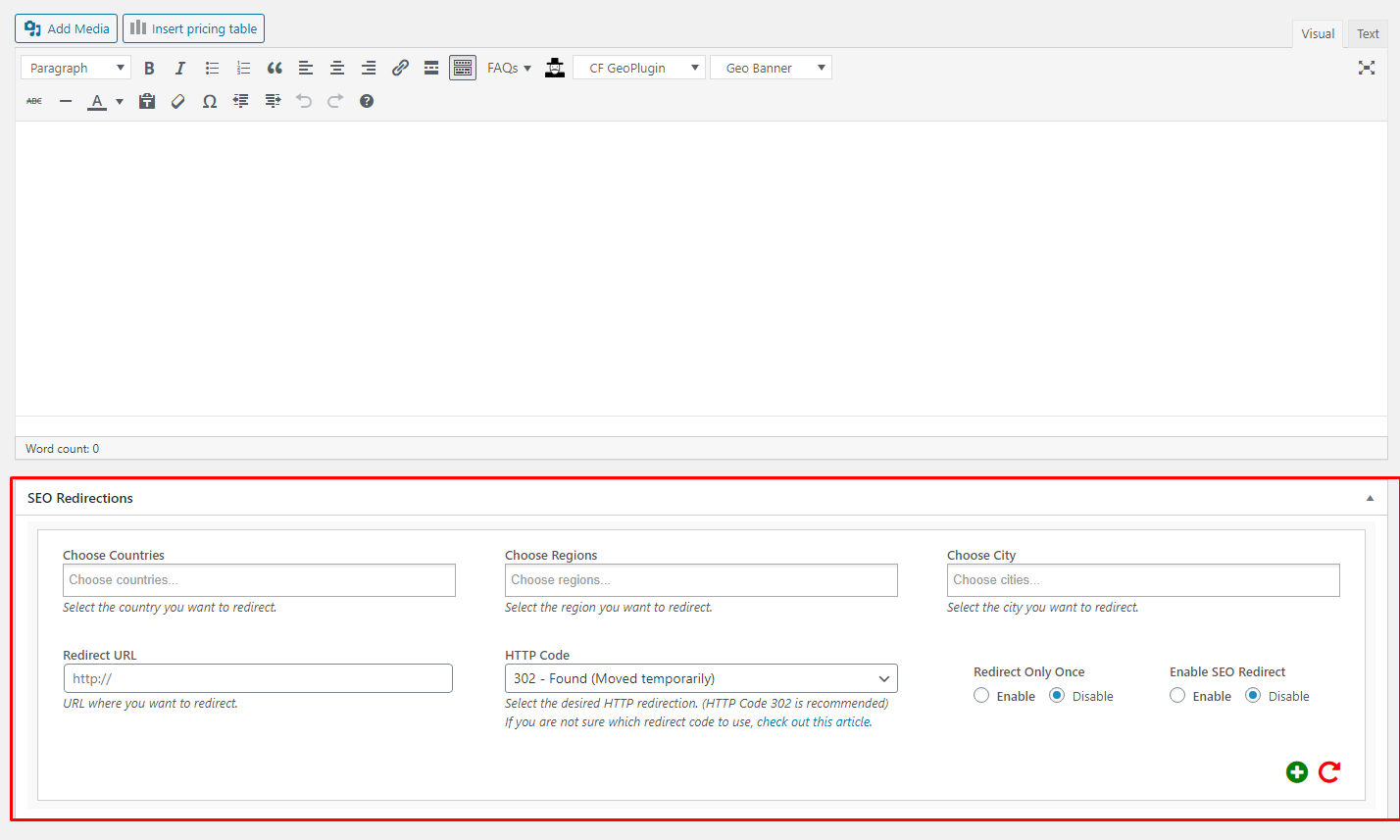Summary
Geolocation SEO redirects are no longer an experiment or a marketing gimmick-they have become one of the most reliable methods to connect user intent with the right regional content and increase conversions. The real challenge today isn't whether redirects by location are possible, but how to implement them without damaging SEO signals, diluting rankings, or frustrating visitors.
This guide explains how to set up geolocation-based SEO redirects in WordPress using WP Geo Controller, relying entirely on the plugin's built-in settings. The approach is simple, transparent, and search-engine friendly. You'll see when to rely on global site-wide rules, when to configure per-post or per-page exceptions, how to handle bulk imports with thousands of entries, and how to enable one-time redirects per session to improve user experience. We'll also cover how to bypass rules for testing and QA, and highlight the mistakes that can harm your site's performance.
All methods shown here are settings-driven-no shortcodes, no custom PHP. For full reference, check the official documentation: SEO Redirection Usage, Bypass Parameters, and Enable SEO Redirection in Post Types.
Why geolocation redirects still matter (and when not to use them)
What they solve:
- Send visitors to regionally relevant content (language, currency, compliance pages).
- Route traffic to the nearest commercial intent (local store, local shipping, market-appropriate pricing).
- Reduce friction on first touch so users don’t hunt for “their version” of a page.
What they don’t solve:
- Thin content. If you redirect to localized pages that aren’t meaningfully different, you risk duplication and lower engagement.
- Bad information architecture. If your site’s regional structure is unclear, redirects become a band-aid-not a strategy.
Goal: Use redirects to reinforce a smart architecture: region folders (/us/, /de/), ccTLDs, or clear subdomains. Pair those with hreflang, canonical tags, and localized content that’s truly useful.
The two control planes: site-wide vs. per-post rules
WP Geo Controller gives you two complementary layers:
- Site-wide SEO redirection
Create global rules that catch broad geo patterns (e.g., “All visitors from DE →/de/“). You can map by country, region, city, and even postcode and assign a specific HTTP status (301/302/303/404). You manage, edit, and delete these rules in one panel and can import/export via CSV when the rule set is large. - Per-post (per-type) SEO redirection
Enable SEO redirection in post types and you’ll see a new redirection meta box on each post/page/custom post. This lets you override global behavior for that one URL-ideal for localized landing pages or campaign pages that need bespoke routing.
When to use which:
- Use site-wide rules for foundational routing (e.g., baseline language/country split).
- Use per-post rules for exceptions, promos, and localized product/offer pages.
Choosing the right HTTP code (and why it matters)
Within the SEO redirection settings, you choose among 301, 302, 303, or even 404 (rare, but sometimes used to retire a geo-restricted page).
- 301 (Moved Permanently): Search engines transfer ranking signals over time. Use when the mapping is stable and long-term (e.g., “DE users should always go to
/de/“). - 302 (Found / Temporary): Use for tests or seasonal campaigns. Avoid leaving 302s in place for months if the intention is actually permanent.
- 303 (See Other): Useful for post-action flows (forms, checkout funnels) to avoid resubmission semantics.
- 404: Only when content should not be accessible for a region and you truly want it removed from discovery. Use sparingly.
Rule of thumb: If your geo structure is durable, prefer 301. If you’re still testing or running a time-boxed campaign, use 302.
More information about HTTP codes can be found here: SEO Redirection in WordPress
Session-friendly UX: “Redirect only once”
A powerful nuance in WP Geo Controller’s CSV model is the “Redirect Only Once” flag (optional column). When enabled, a visitor is redirected only once per session, drastically reducing frustration for users who navigate deeper, bookmark URLs, or use internal search.
Practical effects:
- Better UX: Users won’t get bounced repeatedly while browsing.
- Cleaner analytics: Reduces artificial pageview inflation caused by loops or repeated jumps.
- Fewer support tickets: Power users hate being forced back to a regional homepage every time.
Building your global map: planning rules before you import
Before you touch the settings:
- Decide on a regional structure: subfolders (
/us/,/uk/), subdomains, or ccTLDs. - List your canonical pages per region (home, category index, pricing, store).
- Define fallbacks for ambiguous or unsupported regions (default global page).
- Write down your redirect policy: permanent vs. temporary, session-only behavior, exceptions.
Once planned, you can implement either manually or in bulk.
Site-wide rules: adding, editing, and deleting
Inside SEO Redirection Usage, you can create granular rules by country, region, city, and postcode and assign a destination URL plus the status code. The UI is designed to be approachable, but you still need discipline:
- Keep rules mutually exclusive when possible to avoid conflicts.
- For overlapping rules, remember that more specific rules should take precedence (e.g., city/postcode beats country).
- Keep a policy doc (even a simple spreadsheet) that explains why each rule exists and who owns it.
Bulk imports at scale: the CSV model
If you manage dozens or thousands of redirects, the CSV import saves time:
- Columns: Country code, Region, City, Postcode, Redirect URL, HTTP code, Active (1/0, optional), Redirect Only Once (1/0, optional).
- Caution: Importing replaces all existing rules-use the Backup button first.
- Benefit: Uploads can update your entire map in seconds, keeping configurations version-controlled alongside your deployment process.
Pro tip: Treat the CSV like code-commit it to your repo, name files by date, and review changes (PRs) so the whole team knows what changed and why.
“SEO redirection in post types”: the local override
Enable this setting to surface a Geo Controller redirection box on posts, pages, or custom post types. From any editor screen, assign the desired redirect targets by location for that specific URL. This granular control is perfect for localized campaigns (e.g., /summer-deals/ behaves differently for US vs. EU) without touching global mapping.
Bypassing redirects (for QA, demos, support)
Redirection is great-until you need to test a page without being bounced. WP Geo Controller provides two bypass mechanisms:
?geo=false– a URL parameter to disable redirection temporarily.stop_redirection=true– a REQUEST parameter (can be sent via GET/POST, headers, or cookies), ideal for backend scenarios where you need a clean URL.
Examples from the docs:
https://example.com?geo=false
https://example.com?product=shoes&id=123&geo=false
Or the REQUEST parameter variant:
https://example.com?stop_redirection=true
When to use which:
- Use
geo=falsefor manual, ad-hoc testing and quick demos. - Use
stop_redirection=truefor forms, logins, or API callbacks where query strings should stay clean or where the request comes from non-browser clients.
Bot hygiene: keep crawlers happy
Blocking or misdirecting crawlers can nuke your organic channel. WP Geo Controller exposes bot-friendly options (e.g., Disable Redirection for the Bots) so search engines can crawl the canonical structure without being force-redirected to a geo variant. Combine this with hreflang and well-formed canonicals so Google sees the relationships between alternates correctly.
Checklist for bot safety:
- Enable the plugin’s bot exemption if your architecture relies on canonicals/hreflang.
- Ensure regional pages are reachable in your sitemap.
- Avoid redirecting Googlebot based on IP if you expect it to discover all alternates.
Practical architectures (with redirect posture)
- Single domain + country folders (recommended for many SMEs):
/us/,/de/,/fr/with site-wide 301s on first visit, once per session. Per-post overrides for promotional URLs. Pair with hreflang. - Subdomain regions:
us.example.com,de.example.com-good when infra/teams are regionally split. Redirects can be permanent; ensure cross-property hreflang and consistent nav. - ccTLDs (enterprise/regulatory environments):
example.de,example.fr-highest localization signal, more legal autonomy. Heavier ops burden. Use redirects carefully; ensure the default global domain has a sane fallback.
When not to redirect (and what to do instead)
- Returning users with preferences: If you already know a user chose
/en-gb/, respect it. Let them override geo assumptions. - Content discovery pages: For documentation, blogs, and knowledge bases with shared language, prefer a banner (“It looks like you’re in Germany-view the DE site?”) instead of an auto redirect.
- Organic landing with mixed intent: If the page ranks globally for a topic, avoid auto-redirecting away; use internal links and clear CTAs to the regional variant.
Measuring success (and catching issues early)
KPIs to watch:
- Organic sessions by region (are target regions growing as planned?).
- Bounce rate / time on page for geo-routed landings.
- Conversion rate deltas for users routed vs. not routed.
- Index coverage by region (Search Console) to verify crawl and discoverability.
Debug routine:
- Use the bypass parameters to test a page in “no-redirect mode.”
- Verify both a fresh session (to trigger first-time redirect) and a browsing session (to confirm “once per session” behavior).
- Crawl with a bot setting or a testing tool that simulates Googlebot and normal users to confirm bot exemption works.
How to roll out geo redirects safely (step-by-step)
- Map the content: For every region, list the URLs that should become entry points (home, key categories, pricing).
- Start small: Create site-wide rules for one or two countries first. Test thoroughly.
- Enable per-post overrides for campaign pages only after global redirects look clean.
- QA with bypass: Validate flows with
?geo=falseandstop_redirection=true. - Monitor Search Console: Watch coverage, hreflang validation, and canonical signals post-launch.
- Scale via CSV: When stable, manage the full matrix via CSV (with backups) to keep ops repeatable.
CSV field guide (quick reference)

- Country Code: ISO-2 (e.g., RS, DE, US).
- Region/City/Postcode: Provide only what you need; leave others blank for broader match.
- Redirect URL: Must be a complete, valid URL (https preferred).
- HTTP Status: 301 for permanent, 302 for temporary, 303 for post-action flows.
- Active: 1 to enable, 0 to keep defined but dormant.
- Redirect Only Once: 1 to respect session-only routing; 0 for every hit.
- Backup before import: Import replaces all existing rules.
Common mistakes (and exact fixes)
- Infinite loop: Happens when a rule sends a user to a page that triggers the same rule again.
- Fix: Send users to a stable regional landing that doesn’t match the same redirect condition or mark that destination as excluded.
- Over-eager 301s for experiments:
- Fix: Use 302 for trials; turn into 301 only when confident.
- Redirecting bots:
- Fix: Use the plugin’s bot control setting to disable redirection for crawlers and let hreflang/canonicals do their job.
- No user override:
- Fix: Offer a locale switcher or add a clear “view another region” link. Optional: make session-only redirects the default.
- Testing pain:
- Fix: Use
?geo=falseorstop_redirection=truefor QA, demos, and support cases.
- Fix: Use
Edge cases you should plan for
- Regulatory walls (e.g., content blocked by country): Consider 404 only when necessary; document legal rationale and keep a user-friendly explanation page if possible.
- Postcode granularity: Great for city-specific offers, but ensure data accuracy and provide a country-level fallback.
- CDN/edge behavior: If you also do edge redirects, make sure they don’t conflict with WP rules. Decide on a single source of truth (edge vs. app).
Governance: treating redirects as product, not ops
- Version your CSV and annotate changes.
- Limit who can edit site-wide rules; grant broader rights for per-post overrides if needed.
- Create playbooks: onboarding docs, QA checklists, rollback steps.
- Run quarterly audits: orphaned rules, outdated campaigns, regions that no longer match business reality.
Example rollouts (patterns that work)
A. Two-market SaaS with English UI
-
- Site-wide: US & CA →
/north-america/(301, once per session).
- Site-wide: US & CA →
- EU →
/europe/(301). - Per-post:
/pricing/has overrides for DE/FR sending to localized pricing explanations. - Bots exempt. Hreflang between the three hubs.
B. Retail brand with city-by-city promos
- Site-wide: Country-level 301 to language folder.
- Per-post: Promo pages route by city or postcode to nearest store page.
- Session-only enabled to reduce bounce irritation.
C. Publisher with mixed global traffic
- Site-wide: Minimal redirects; content is language-agnostic.
- Per-post: Only used for subscription offers (geo-priced), not editorial content.
- Banner suggests local edition instead of auto-redirect for articles.
Frequently asked questions
Do geolocation redirects hurt SEO?
Not inherently. They hurt SEO when they block crawlers, cause loops, or mask duplicate content. Use bot exemption, hreflang, and provide unique localized content for key pages.
Should I always use 301?
Use 301 for stable mappings you expect to keep. Use 302 for tests or seasonal routing.
Can I redirect only the first time a user visits?
Yes-via the Redirect Only Once option in the CSV model (session-scoped behavior).
How do I test a page without getting redirected?
Append ?geo=false or use stop_redirection=true (GET/POST/headers/cookies) to bypass.
Can I manage redirects for individual pages?
Yes-enable SEO Redirection in Post Types and configure redirects from the post/page editor screen.
Implementation links
- SEO Redirection Usage (site-wide rules, CSV import/export, HTTP codes, session-only column).
- How to bypass SEO redirection (
geo=false,stop_redirection=true). - Enable SEO Redirection in Post Types (per-post/per-page settings).
Final takeaway
Geolocation SEO redirects work best when they’re predictable, minimal, and respectful:
- Predictable: clear country → destination mapping, right HTTP codes.
- Minimal: redirect only once per session when possible.
- Respectful: let bots crawl the structure; let users override assumptions.
With WP Geo Controller, you don’t need custom code to do any of this. You build the logic in site-wide settings, sprinkle exceptions via per-post controls, control the session experience, and keep your sanity with CSV import/export and bypass switches for QA.
Deploy deliberately, measure obsessively, and keep refining your rules as your markets evolve. That’s how geo redirects serve both users and rankings-and not the other way around.
Click to Download latest Geo Controller version 8.9.4





